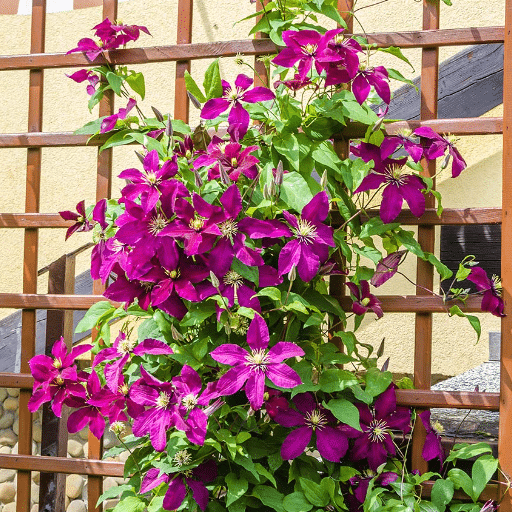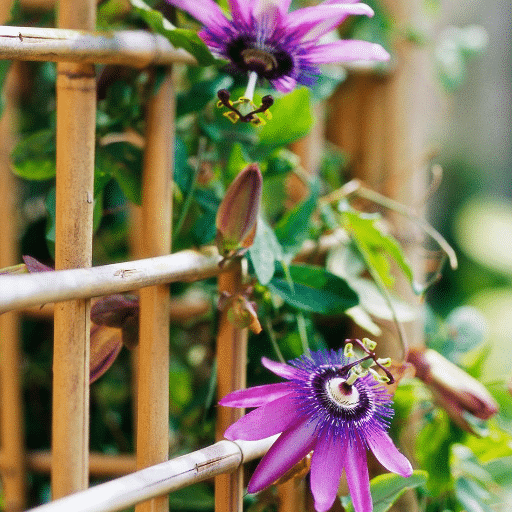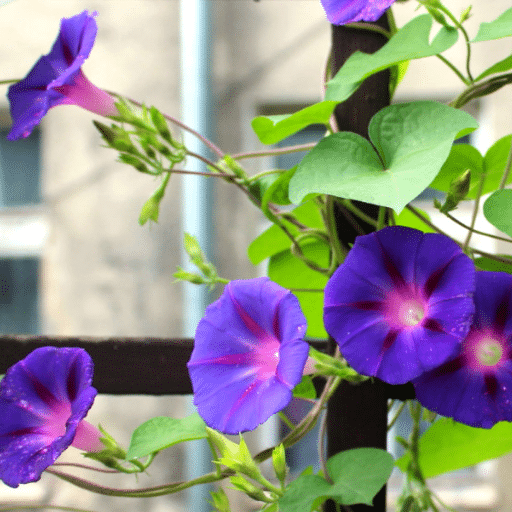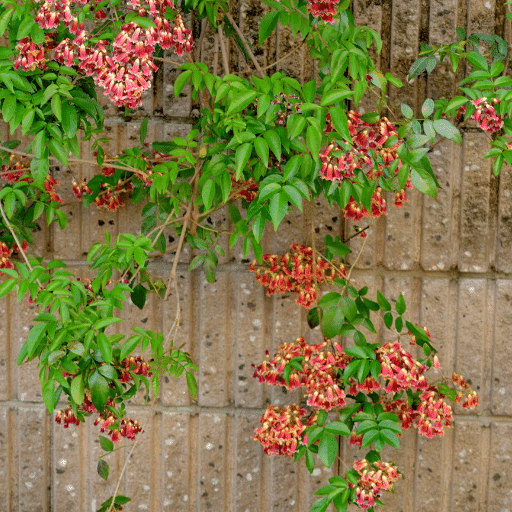Transform your garden into a vertical paradise! blooming vines bring warmth, color, and life to any outdoor space. They turn plain walls and fences into stunning living displays while providing practical benefits like privacy, shade, and pollinator habitat. This comprehensive guide will help you select, grow, and maintain the perfect flowering vines for your garden.
What are Flowering Vines?

Flowering vines are climbing plants that offer both aesthetic and functional advantages in any landscape. These versatile plants are characterized by their ability to:
- Climb and spread using twining stems, tendrils, or clinging mechanisms
- Produce colorful blooms in shades of pink, orange, yellow, purple, and white
- Grow vertically on trellises, fences, walls, or hanging baskets
- Provide habitat for beneficial insects like bees and butterflies
- Create focal points that enhance your garden’s design
Benefits of Growing Blooming Vines
| Benefit | Description | Best Vine Options |
|---|---|---|
| Visual Appeal | Add color and texture to plain spaces | Clematis, Bougainvillea, Morning Glory |
| Privacy & Shade | Screen unsightly areas and create cool zones | Climbing Hydrangea, Boston Ivy |
| Pollinator Support | Attract bees, butterflies, and hummingbirds | Trumpet Vine, Honeysuckle, Carolina Jessamine |
| Space Efficiency | Maximize gardening in small areas | Star Jasmine, Black-Eyed Susan Vine |
| Year-Round Interest | Evergreen varieties provide constant coverage | Jasmine, Carolina Jessamine |
Choosing the Right Vine for Your Garden
Selecting the perfect flowering vine requires careful consideration of several key factors:
Site Conditions to Evaluate
- Sunlight Requirements
- Full sun (6+ hours): Trumpet vine, Morning glory
- Partial shade: Climbing hydrangea, Some clematis varieties
- Full shade: Boston ivy, Some honeysuckle varieties
- Soil Type
- Well-draining soil is essential for most vines
- Add organic matter to improve soil quality
- Consider pH requirements for specific varieties
- Climate Zone
- Check USDA hardiness zones for your area
- Consider annual vs. perennial options
- Factor in local weather patterns
Design Goals
Popular Blooming Vines

Clematis: The Queen of Vines
Clematis earns its royal title through versatility and stunning blooms. This beloved vine offers:
- Diverse varieties: From large-flowered hybrids to delicate species
- Color range: White, pink, purple, red, and yellow blooms
- Bloom times: Spring, summer, or fall flowering varieties
- Size options: Compact varieties for containers to vigorous climbers
Honeysuckle: Sweet and Fragrant
Honeysuckle combines beautiful flowers with an intoxicating fragrance. Key features include:
- Fragrant blooms: Evening fragrance attracts night pollinators
- Hummingbird magnet: Tubular flowers perfect for hummingbirds
- Easy care: Tolerates various soil conditions
- Multiple colors: White, yellow, pink, and coral varieties
Climbing Hydrangea: A Stunning Perennial
This elegant vine excels in challenging conditions:
- Shade tolerant: Thrives in partial to full shade
- Self-clinging: Attaches to walls without support structures
- Seasonal interest: White flower clusters and attractive bark
- Slow establishment: Takes 2-3 years to become established
Vines for Specific Garden Features

Best Vines for Trellises
| Vine Type | Growth Habit | Flower Color | Special Features |
|---|---|---|---|
| Clematis | Twining stems | Various | Elegant, manageable size |
| Sweet Pea | Tendril climber | Pastels | Fragrant, cool weather |
| Black-Eyed Susan Vine | Twining | Yellow/Orange | Continuous blooming |
| Morning Glory | Twining | Blue, Purple, Pink | Fast-growing annual |
Best Vines for Fences
When selecting vines for fence coverage, consider these top performers:
- Trumpet Vine – Fast-growing with orange-red blooms that attract hummingbirds
- Star Jasmine – Evergreen with fragrant white flowers, perfect for year-round coverage
- Climbing Rose – Classic choice with repeat blooming and thorny protection
- Boston Ivy – Dense coverage with stunning fall color
Creating Arbors with Flowering Vines
Arbor Success Tips:
- Choose vigorous growers like Wisteria or Grape vines
- Ensure your arbor can support mature vine weight
- Plan for regular pruning to maintain shape
- Consider bloom timing for maximum impact
Fast-Growing Flowering Vines

For quick results and instant garden transformation, these vines deliver rapid growth and abundant blooms:
Trumpet Vine: A Vibrant Choice
- Growth rate: Can reach 12 feet in a single season
- Bloom period: Summer through fall
- Colors: Orange, red, yellow trumpet-shaped flowers
- Wildlife value: Hummingbird favorite
- Hardiness: USDA zones 4-9
Black-Eyed Susan Vine: Cheerful and Bright
- Height: 6-8 feet with support
- Flowers: Yellow to orange with distinctive black centers
- Light: Full sun to partial shade
- Use: Excellent for containers, hanging baskets, or small trellises
Morning Glories: Quick Bloomers
- Germination: Blooms 2-3 months after planting
- Care: Low maintenance, drought-tolerant once established
- Colors: Blue, purple, pink, white, and bi-colors
- Special feature: Flowers open in the morning, close in afternoon heat
Maintenance and Care for Flowering Vines

Essential Support Structures
Proper support is crucial for vine health and appearance:
| Support Type | Best For | Installation Tips |
|---|---|---|
| Trellises | Clematis, Sweet peas | Install before planting, ensure adequate spacing |
| Wire frameworks | Heavy vines like Wisteria | Use galvanized wire, tension properly |
| Arbors/Pergolas | Grape vines, Climbing roses | Build to support mature vine weight |
| Wall attachments | Self-clinging vines | Consider wall material and vine type |
Watering and Fertilizing
Proper nutrition and hydration keep vines healthy and blooming:
- Watering schedule: Deep, infrequent watering promotes deep root growth
- Soil moisture: Allow top inch to dry between waterings
- Fertilizer type: Balanced or low-nitrogen formulations
- Application timing: Every 4-6 weeks during growing season
- Avoid: Overwatering and overfertilizing
Pruning Techniques for Healthy Growth
Strategic pruning maintains vine health and appearance:
- Remove dead or damaged wood first to promote plant health
- Prune after blooming to shape and encourage new growth
- Thin overcrowded areas to improve air circulation
- Use clean, sharp tools to prevent disease transmission
- Cut above healthy buds or leaf nodes for best results
Pest and Disease Management
Prevention First Approach:
- Regular inspection for early problem detection
- Proper spacing for good air circulation
- Natural treatments like neem oil or insecticidal soap
- Immediate removal of infected plant material
- Maintain garden cleanliness and sanitation
References
-
21 Best Flowering Vines to Grow – A comprehensive guide on flowering vines, their sizes, colors, and how they can enhance gardening spaces.
-
Ornamental Vines – Insights from the Missouri Botanical Garden on how vines add vertical interest and hide unsightly views.
-
Growing Vines Successfully – A detailed article from the Brooklyn Botanic Garden on pruning, planting, and maintaining vines.
Frequently Asked Questions (FAQ)
What are the best perennial flowering vines for my garden?
In selecting perennial flowering vines for your garden, go for the clematis, which displays every color imaginable and showy flowers from spring through fall into the summer months. Another good choice is the climbing hydrangea with its alluring white flowers that cluster and bloom from late spring through summer. Carolina jessamine is a tender perennial vine with yellow flowers that attract hummingbirds to grace any garden space. In contrast, chocolate vine, with its exotic blooms and fast nature, can add some exotic charm. Make sure to provide a trellis or fence for the vines to climb upon and thrive.
How do I grow a trumpet vine effectively?
To grow trumpet vine properly, first plant it in a sun-drenched spot where it will receive approximately six hours of direct sunlight daily. This spirited climber reaches great heights with trumpet-shaped flowers that attract birds and other pollinators from summer to fall. It should be well-supported by a sturdy trellis or arbor because this species can weigh heavily with age. Not only does it require regular pruning to control growth and maintain flowering, but also to ensure it does not overshadow other plants. When well attended to, this vine can shine in every garden as a stunning focal point.
What types of flowering vines can I grow indoors?
Some of the easier and accessible flowering vines you may want to grow indoors include Sweet Pea and Purple Bell Vine, both thriving well in pots given adequate light. The Cup and Saucer Vines are another beautiful option, given their charming flowers and their ability to acclimatize inside. Consider providing these vines with a small trellis to give them some support as they grow. Altogether, the Hyacinth Bean would also be very nice, with its distinct purple flowers attracting attention. These vines must be watered regularly so that they drain well; thus, they will grow well inside the house.
What are some climbing vines that attract hummingbirds?
Climbing vines like trumpet vine and firecracker vine attract hummingbirds. Their tubular flowers are well-known to lure these birds in. Carolina jessamine acts as another worthy option, having fragrant yellow flowers that bloom profusely, especially drawing the attention of hummingbirds during migration. Another considered choice of vine that promises to attract hummingbirds is the morning glories, which bring color abundantly and can be plainly grown on trellises, creating a striking display. Give these vines a lot of sun to accelerate their growth and flowering.
How can I care for my saucer vine to ensure healthy growth?
Well-draining soil is best for your saucer vine; full sun exposure is care for maximal flower development. These vines love the heat and flower from summers into autumn with peculiar, cup-shaped blossoms. Water them continuously, but don’t keep the soil soggy-or root rot might go creeping in. Pruning in early spring also keeps the vine in shape and induces bloom production for more; a sturdy support structure, like a trellis, will give the vine ample climbing space and showcase the flowers beautifully.





